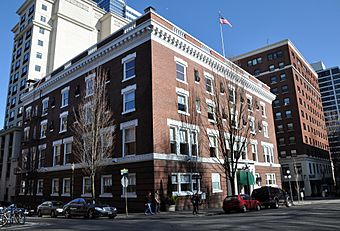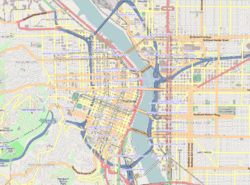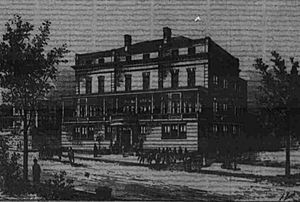Arlington Club facts for kids
Quick facts for kids |
|
|
Arlington Club
|
|

The Arlington Club in 2010.
|
|
| Location | 811 SW Salmon Street Portland, Oregon |
|---|---|
| Built | 1909 |
| Architect | Whidden & Lewis |
| Architectural style | Georgian Revival |
| MPS | Historic Resources in Downtown Portland, Oregon, MPS |
| NRHP reference No. | 10000599 |
| Added to NRHP | August 30, 2010 |
The Arlington Club is a private social club in Portland, Oregon. It was started in 1867 by 35 important business and banking leaders. At first, it was called the Social Club. Later, it was renamed the Arlington Club. For many years, it was mainly for men who were leaders in business and banking.
Over its first 100 years, more than 3,300 men were members. Many of these members were also leaders in community groups. Some even held important government jobs.
For a long time, the club did not allow Jewish people or other minority groups to join. For 123 years, it also did not allow women. Because of public pressure, the club changed its rules. By the late 1960s, more men could join. In 1990, women were finally allowed to become members. The Arlington Club still meets at its building in downtown Portland today.
Contents
History of the Arlington Club
In 1867, Simeon Gannett Reed and 34 other men from Portland started the Social Club. Their goal was to "fraternize for mutual enjoyment and relaxation." They also wanted a place to discuss their future and Portland's future. This club became a main meeting spot for Portland's important male leaders.
For many years, the club was mostly made up of white men. These men were leaders in the city's business and banking world. Some founders included John C. Ainsworth from Ainsworth National Bank. Henry Failing was another founder, involved in many businesses. William S. Ladd and Donald Macleay were also key founders. These men had a big impact on Portland.
Early Members and Their Influence
Historian Paul G. Merriam described the city's early important people. These included the members of the Social Club. They were mostly businessmen and their close friends, like lawyers. These important families owned a lot of property. They were also leaders in many community groups.
In 1870, there were 38 such men in Portland. Many of them held local government jobs. Some even held state and federal positions. Most were Republicans, but some were Democrats. They often worked together no matter their political party.
Club's Role in Portland
The club wanted to be like older private clubs in Europe and other American cities. But it also cared about the community. Many members were important community leaders. However, some historians say that members sometimes thought their own interests were the same as the city's interests.
Historian E. Kimbark MacColl noted that in the 1890s, what was good for the club was often seen as good for the city. Many big decisions about Portland's business and politics were made during informal talks at the club.
Important people from banks, utility companies, and railroads were members. Even U.S. Senators from Oregon were part of the club. In the 1890s, four or five club members were usually in the Oregon Legislature. Other clubs formed in the 1890s, like the Multnomah Athletic Club. Members often belonged to more than one club. The Concordia Club was a similar club for Jewish people. The Arlington Club did not allow Jewish members at that time.
Notable People Connected to the Club
Many famous people were members between 1867 and 1967. George Henry Williams was one. He was a Chief Justice, a U.S. Senator, and even the United States Attorney General. He also became mayor of Portland.
Frederick Van Voorhies Holman was another important member. He was a lawyer for an electric company. He also supported the arts and wrote a book about John McLoughlin. Journalist Harvey W. Scott, who edited The Oregonian newspaper, was also a member. Lewis A. McArthur, who wrote Oregon Geographic Names, was also on the list. University presidents, a bishop, and an Air Force general were also members.
Many well-known guests visited the club. These included U.S. presidents William Howard Taft, Rutherford B. Hayes, and Ulysses S. Grant. Famous author Aldous Huxley also visited. Other guests included heart surgeon Michael E. DeBakey and General George C. Marshall.
Club Meeting Places and Buildings
For its first 14 years, the club met in different places. They used dining rooms, hotels, or government offices. In 1881, the club reorganized and changed its name to the Arlington Club. By then, it had about 100 members. It moved into its first clubhouse. This was the old home of J.C. Ainsworth.
The club built its second clubhouse at West Park Avenue and Alder Street. They used this building from 1892 to 1910. Then, they moved to the building they still use today. This building is on Southwest Salmon Street, facing the South Park Blocks.
The current building is four stories tall. It is made of brick and terra cotta and has a classic style. The architects were William M. Whidden and Ion Lewis. The Park Blocks near the clubhouse have churches, the Portland Art Museum, and the Oregon Historical Society Museum. Portland State University is also nearby. The building was added to the National Register of Historic Places in August 2010.
Changes in Membership
From the very beginning, only business and community leaders were invited to join. About 3,300 men joined during the club's first 100 years. But other groups were not allowed. Jewish people and ethnic minorities were not allowed until the late 1960s. This change happened after Jewish leaders, like federal judge Gus Solomon, spoke out against the rules.
Changes happened slowly. The Oregonian newspaper reported in 1989 that Jewish people and ethnic minorities made up less than 3 percent of the members. There were no African American members at that time.
Women Join the Club
In October 1989, the Portland City Council asked the Arlington Club to allow women. They pointed to a federal law that bans discrimination based on gender. At that time, the Arlington Club had about 500 members. Women were not usually allowed inside the building.
During the City Council meeting, five women spoke. They represented different legal and business groups. They said that the club's rules kept women from business chances that men had. One woman spoke against the idea, saying clubs should be able to choose their members.
In March 1990, the Arlington Club members voted. The vote was 320 to 145 to allow women to join. This was more than the two-thirds vote needed to change the rules. So, after 123 years, women were finally allowed to become members. The club building was updated to add women's restrooms and a lounge. Women were officially allowed starting February 11, 1991. The Arlington Club still meets at its building in downtown Portland today.
See also
- List of American gentlemen's clubs



